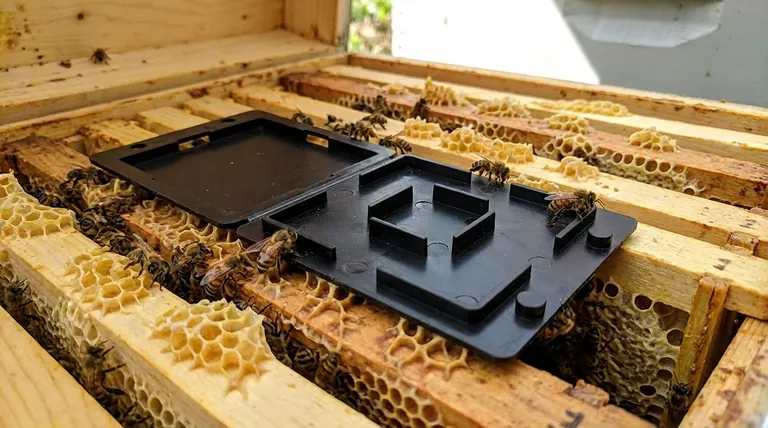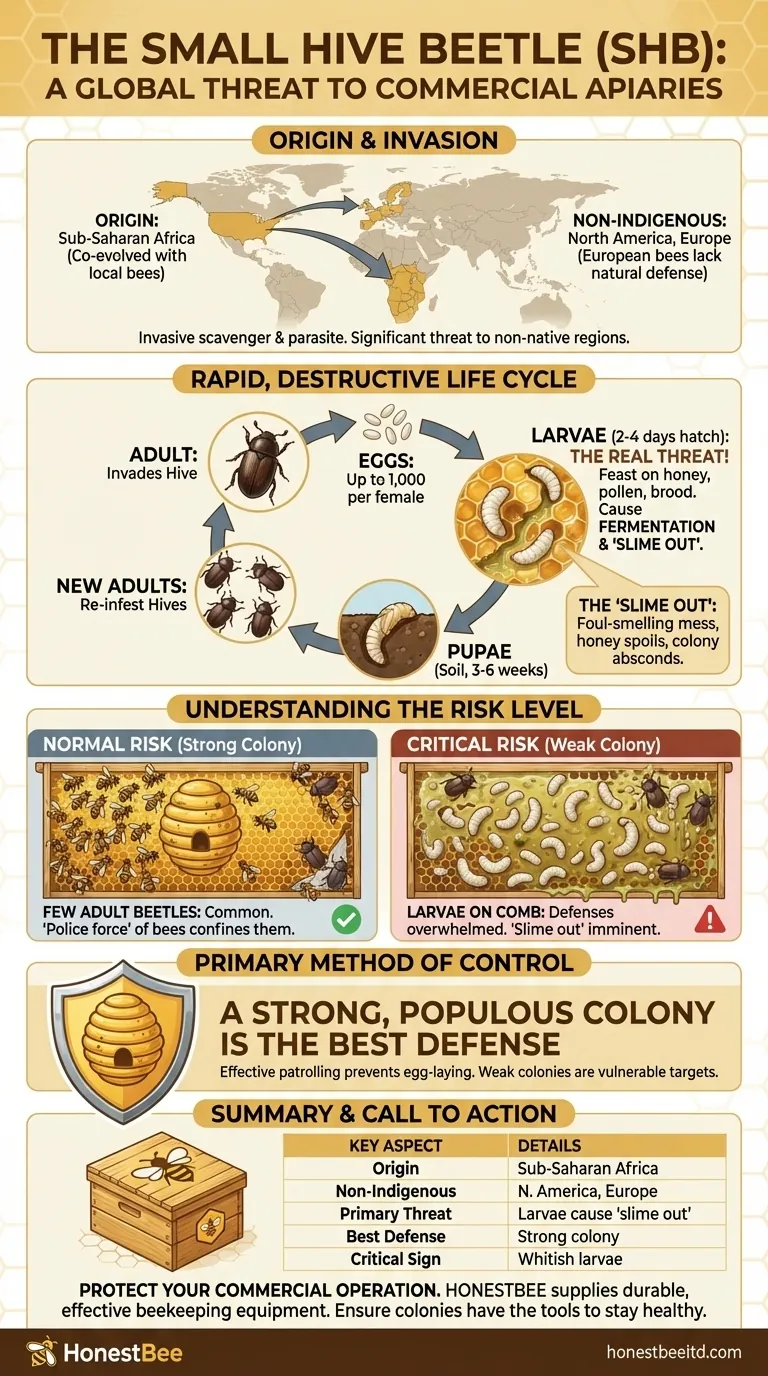In short, the small hive beetle (SHB) is a scavenger and parasite of honey bee colonies. It is an invasive pest that is not indigenous to North America or Europe, where the local European honey bees struggle to control it, making it a significant threat to beekeepers in those regions.
The core issue is not the presence of a few adult beetles, but their potential for rapid, destructive reproduction. A strong, populous honey bee colony is the primary defense, as it can police the beetles and prevent a catastrophic larval infestation.

The Nature of the Threat
An Invasive Species
The small hive beetle originates from sub-Saharan Africa. Because it is not native to North America or Europe, the European honey bee subspecies commonly used in those areas have not evolved effective, natural defenses against it.
This lack of co-evolution means beekeepers must be vigilant, as their colonies are more vulnerable to beetle infestations than African honey bee subspecies.
The Beetle's Rapid Life Cycle
The danger of the SHB lies in its incredibly fast and prolific reproductive cycle. A single female can lay up to 1,000 eggs in her lifetime.
These eggs hatch into larvae in just 2-4 days. The larvae then feast on honey, pollen, and even bee eggs and brood for 7-10 days before leaving the hive to pupate in the soil. After 3-6 weeks, they emerge as adults, ready to re-infest hives.
The "Slime Out"
The most destructive damage is done by the beetle larvae. As they tunnel through the comb, they defecate in the honey, causing it to ferment and run out of the cells.
This creates a foul-smelling, slimy mess that spoils all the honey and pollen stores. If an infestation is severe, the bee colony will often abscond, abandoning the hive entirely. This event is commonly known as a "slime out."
Understanding the Risk Level
A Few Beetles Are Normal
Seeing a few adult beetles in a hive is not necessarily a cause for alarm. Much like seeing a single cockroach in a home, it is a common occurrence.
A strong, healthy colony has a "police force" of worker bees that will chase and confine the beetles to cracks and crevices, preventing them from accessing the comb to lay eggs.
The True Danger Signal
The situation becomes critical when you see the beetle larvae. These small, whitish worms crawling on the comb surface are the unmistakable sign of an active, uncontrolled infestation.
The presence of larvae means the beetles have successfully reproduced, and the colony's defenses have been overwhelmed. This is the point where the risk of a "slime out" becomes very high.
The Primary Method of Control
A Strong Colony is the Best Defense
The single most effective way to control small hive beetles is to maintain a strong, populous, and healthy honey bee colony.
A large population of bees can effectively patrol the entire hive, ensuring that any adult beetles are quickly corralled and prevented from laying eggs. The beetles cannot gain a foothold in a hive that is well-defended.
Weak Colonies are a Target
Conversely, weak or shrinking colonies are extremely vulnerable. They lack the bee population required to police the hive space.
This provides the perfect opportunity for beetles to lay eggs on the combs, leading to a larval infestation that the weakened colony cannot fight. This is often the final blow for an already struggling hive.
How to Apply This to Your Hive
A beekeeper's response should be directly tied to what they observe inside the colony.
- If your primary focus is routine inspection: Seeing a few adult beetles is normal; concentrate your efforts on ensuring the queen is laying well and the colony has ample food and population.
- If your primary focus is saving a weak hive: Be hyper-vigilant for SHB, as your colony is a prime target. Consider reducing the hive space to help the smaller population defend it more effectively.
- If your primary focus is responding to an infestation: The sight of larvae and slime means the hive is in critical condition and the bees' own defenses have failed, requiring immediate intervention with traps or other treatments.
Ultimately, proactive beekeeping that promotes colony health is your most powerful tool against this invasive pest.
Summary Table:
| Key Aspect | Details |
|---|---|
| Origin | Sub-Saharan Africa |
| Non-Indigenous Regions | North America, Europe |
| Primary Threat | Larvae cause 'slime out,' destroying honey and pollen stores |
| Best Defense | A strong, populous honey bee colony |
| Critical Sign | Presence of whitish beetle larvae on comb |
Protect your commercial operation from devastating hive beetle infestations. HONESTBEE supplies durable, effective beekeeping equipment and supplies to commercial apiaries and distributors. A strong hive is your best defense—ensure your colonies have the right tools to stay healthy and productive. Contact our wholesale experts today to discuss your apiary's needs.
Visual Guide

Related Products
- Black Plastic Beetle Barn Hive Beetle Trap for Beehives
- Reusable Clear Small Hive Beetle Traps for Beehives Beetle Trapping Tools
- Reusable Aluminium Beetle Trap for Small Hive Beetles Silver Bullet
- Removable Washable Hive Beetle Trap Attractants for Small Hive Beetles
- Plastic Beetle Blaster Trap Beekeeping Tools and Supplies
People Also Ask
- What is the best time to use beetle traps? Master the Spring Strategy for Effective Hive Protection
- What should be done if a hive shows signs of a small hive beetle infestation? Protect Your Hive Now
- How should beetle traps be placed in the hive? Achieve Perfect Flush Placement for Maximum Control
- What are the chemical-free options for trapping hive beetles? Control Pests Without Chemicals
- What is the recommended number of beetle traps per hive? Optimize Your Hive's Beetle Defense



















